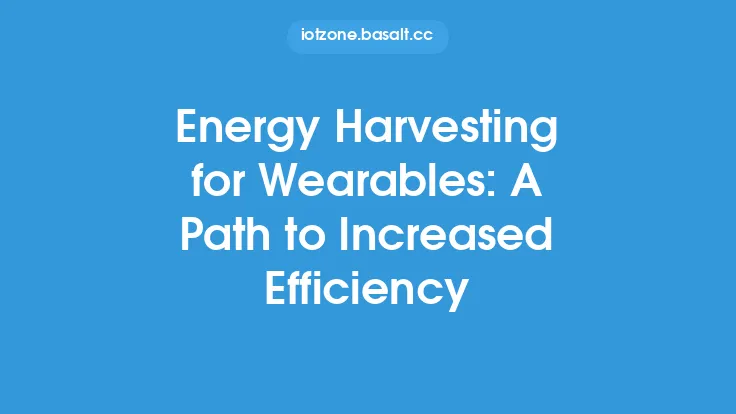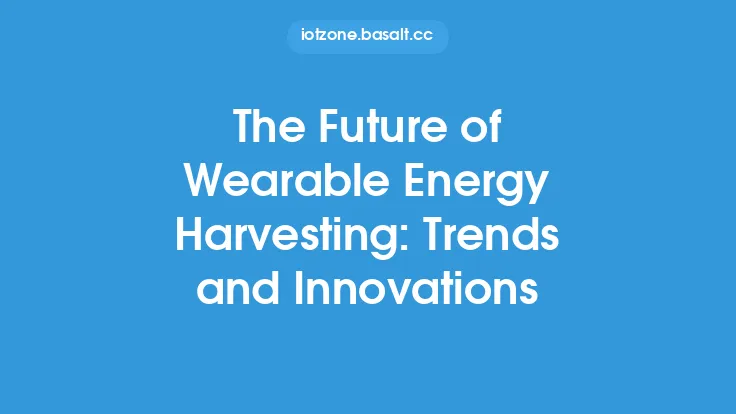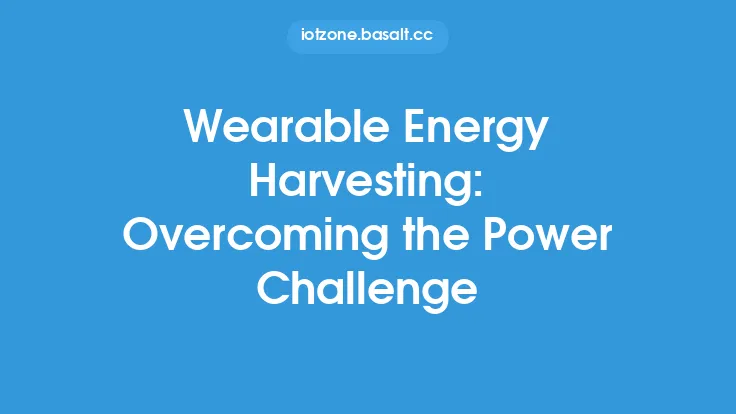Wearable energy harvesting is a technology that enables wearable devices to harness energy from their environment, converting it into electrical energy to power the device. This technology has gained significant attention in recent years due to its potential to provide a sustainable and reliable source of power for wearable devices. The principles of wearable energy harvesting are based on the concept of converting ambient energy into electrical energy, which can be achieved through various methods, including piezoelectric, thermoelectric, electrostatic, and photovoltaic energy harvesting.
Introduction to Wearable Energy Harvesting Principles
The principles of wearable energy harvesting involve the use of energy harvesting materials and technologies to convert ambient energy into electrical energy. Piezoelectric energy harvesting, for example, uses materials that generate an electric charge in response to mechanical stress, such as vibrations or pressure. Thermoelectric energy harvesting, on the other hand, uses materials that generate an electric potential difference in response to temperature differences. Electrostatic energy harvesting uses materials that generate an electric charge in response to changes in capacitance, while photovoltaic energy harvesting uses materials that convert light into electrical energy.
Types of Wearable Energy Harvesting Technologies
There are several types of wearable energy harvesting technologies, each with its own advantages and disadvantages. Piezoelectric energy harvesting, for example, is suitable for applications where mechanical stress is present, such as in wearable devices that are subject to vibrations or pressure. Thermoelectric energy harvesting is suitable for applications where temperature differences are present, such as in wearable devices that are worn on the body. Electrostatic energy harvesting is suitable for applications where changes in capacitance are present, such as in wearable devices that use electrostatic sensors. Photovoltaic energy harvesting is suitable for applications where light is present, such as in wearable devices that are worn outdoors.
Wearable Energy Harvesting Materials and Devices
Wearable energy harvesting materials and devices are designed to convert ambient energy into electrical energy. These materials and devices can be integrated into wearable devices, such as smartwatches, fitness trackers, and smart clothing. The choice of material and device depends on the specific application and the type of energy being harvested. For example, piezoelectric materials such as lead zirconate titanate (PZT) and polyvinylidene fluoride (PVDF) are commonly used for piezoelectric energy harvesting, while thermoelectric materials such as bismuth telluride (Bi2Te3) and lead telluride (PbTe) are commonly used for thermoelectric energy harvesting.
Applications of Wearable Energy Harvesting
Wearable energy harvesting has a wide range of applications, including consumer electronics, healthcare, and sports. In consumer electronics, wearable energy harvesting can be used to power devices such as smartwatches and fitness trackers, reducing the need for batteries and extending the device's lifespan. In healthcare, wearable energy harvesting can be used to power devices such as pacemakers and implantable cardioverter-defibrillators (ICDs), reducing the need for battery replacements and minimizing the risk of device failure. In sports, wearable energy harvesting can be used to power devices such as wearable sensors and GPS trackers, providing athletes with real-time feedback and performance metrics.
Challenges and Limitations of Wearable Energy Harvesting
Despite the potential of wearable energy harvesting, there are several challenges and limitations that need to be addressed. One of the main challenges is the low power output of wearable energy harvesting devices, which can make it difficult to power devices that require high amounts of energy. Another challenge is the efficiency of wearable energy harvesting devices, which can be affected by factors such as the type of energy being harvested and the materials used. Additionally, wearable energy harvesting devices can be bulky and uncomfortable to wear, which can limit their adoption and use.
Future Directions of Wearable Energy Harvesting
The future of wearable energy harvesting is promising, with advances in materials and technologies expected to improve the efficiency and power output of wearable energy harvesting devices. One area of research is the development of new materials and devices that can harness energy from multiple sources, such as vibrations, temperature differences, and light. Another area of research is the development of wearable energy harvesting devices that can be integrated into clothing and textiles, providing a more comfortable and convenient way to harvest energy. Additionally, the use of artificial intelligence and machine learning algorithms can help optimize the performance of wearable energy harvesting devices, improving their efficiency and power output.
Conclusion
Wearable energy harvesting is a technology that has the potential to provide a sustainable and reliable source of power for wearable devices. The principles of wearable energy harvesting involve the use of energy harvesting materials and technologies to convert ambient energy into electrical energy. There are several types of wearable energy harvesting technologies, each with its own advantages and disadvantages. Wearable energy harvesting materials and devices can be integrated into wearable devices, providing a wide range of applications in consumer electronics, healthcare, and sports. Despite the challenges and limitations of wearable energy harvesting, the future of this technology is promising, with advances in materials and technologies expected to improve the efficiency and power output of wearable energy harvesting devices.





